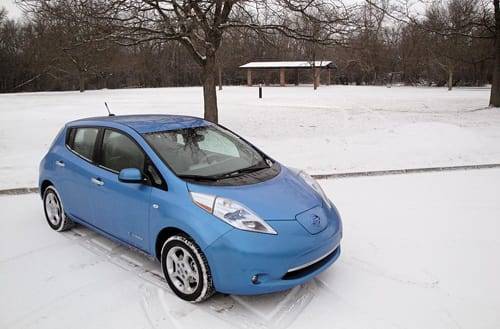2012 Nissan Leaf Battery Warmer: More Details


As we reported in our post about Nissan’s 2012 lineup changes, the 2012 Leaf electric car will include some cold-weather provisions as standard equipment. We bought our Leaf knowing it wasn’t prepared for winter conditions and were told of a coming “cold package” that in future models would add heated seats, steering wheel and side mirrors as well as more battery insulation.
What surprised us was the inclusion of what Nissan called a “battery heater” on a car whose battery pack is not otherwise thermally managed. Most battery-electric cars — current and future — use liquid or forced-air battery heating and/or cooling.
We were then surprised to learn that the battery warmer comes into play only at temperatures below minus 10 degrees Celsius (14 degrees Fahrenheit) … when the car is not plugged into a charger. This is a very different kind of heater — in essence, a battery-powered battery warmer.
Unlike EVs with liquid heating, which use grid power to maintain a minimum battery temperature and preserve range, the Leaf’s battery heater will activate to ensure acceptable performance when temperatures are near 0 degrees Fahrenheit. Batteries already lose power as temperatures drop, and at subfreezing temps, acceleration is compromised. At roughly minus 22 degrees Fahrenheit (minus 30 degrees Celsius), battery-electric and some hybrid cars simply won’t turn on.
“We weren’t scared that someone couldn’t merge on the freeway,” said Mark Perry, director of product planning for Nissan North America. “We were protecting against the no-start condition, if somebody happens to leave their car outside in subzero, a remote lot at the airport, not plugged in, not driven.”
In this case, the battery heater uses its stored energy to power resistive heating elements that draw less than 0.3 kilowatts (300 watts). Once again, no liquid or fans are involved. For comparison, hair dryers typically use more than 1.5kW, the Leaf’s battery recharges at 3.3 kW when connected to a 240-volt charger, and in the dead of winter we saw our Leaf’s cabin heater draw as much as 4.5 kW for brief periods. The battery pack is rated at 24 kilowatt-hours, so if it had, say, 16 kWh of charge left, you might think the heater would run it down in 53 hours — but it doesn’t work that way.
When the car is driven or plugged in (even after the battery is fully charged), enough heat is generated to keep the battery warm, Perry said. The Leaf’s chief engineer, Hidetoshi Kadota, noted that the Leaf would have to be in the harsh conditions for a couple of days before the battery heater would come into play. The new battery insulation helps retain the heat. For the same reason, the battery heater doesn’t stay on full-time even once it starts.
Perry said the need for the heater will be extremely rare. “But what do engineers do?” he asked. “They protect against the 1 percent chance.”
The cold package isn’t an option package; it will be standard on all 2012 Leafs. Unfortunately, the battery heater won’t extend the car’s range, as the thermal management does in the Chevy Volt. However, the front and rear seat heaters probably will. They allow occupants to use the cabin heat much less.
The 2012 models begin production this summer.

Former Executive Editor Joe Wiesenfelder, a Cars.com launch veteran, led the car evaluation effort. He owns a 1984 Mercedes 300D and a 2002 Mazda Miata SE.
Featured stories




